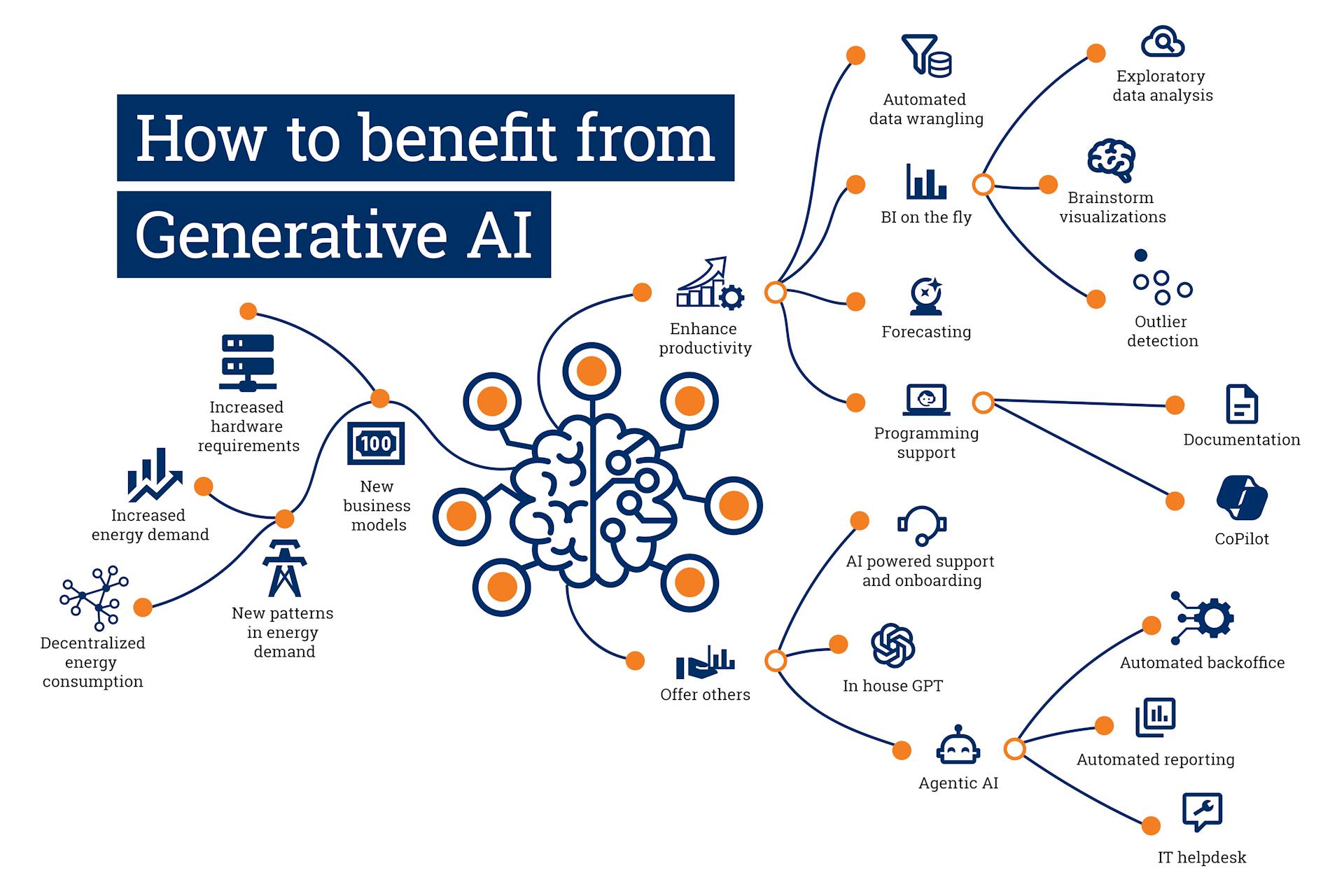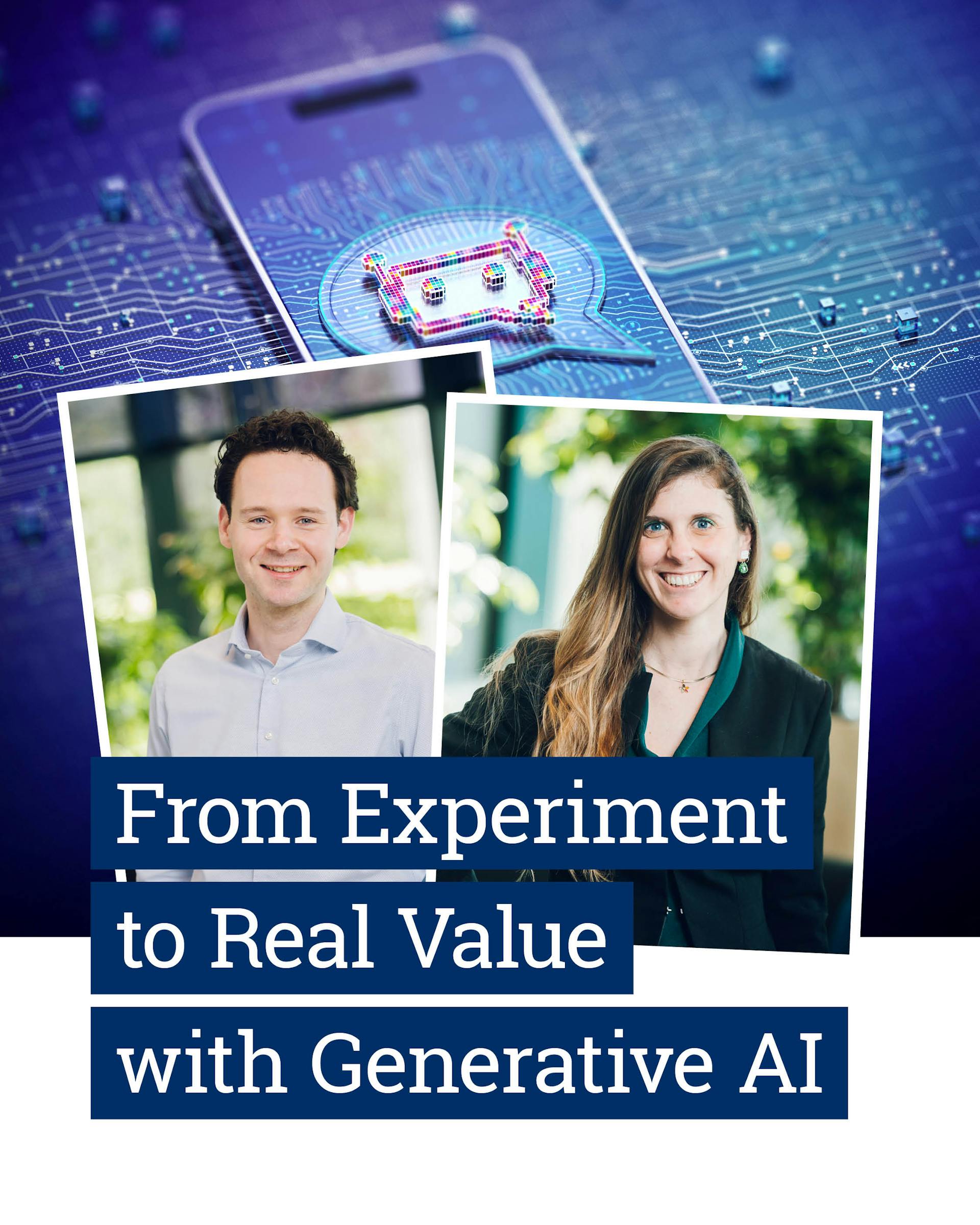Understanding Generative AI (GenAI)
Generative AI (GenAI) has become a buzzword, but what does it really mean? According to Sander Vlot, it’s a broad category of AI technologies that all create new content. “Generative AI is an umbrella term - it covers any AI that generates content, whether that’s text, images, video, or sound,” he explains. At the heart of this technology are large language models (LLMs) wrapped in a chat interface such as ChatGPT or Claude, which specialize in generating human-like text. Erica D’Acunto adds a technical perspective: “It’s all based on neural networks, typically using a transformer architecture.” This architecture enables AI to identify and replicate language patterns with remarkable fluency, making it feel almost intuitive. Agentic AI goes even further and uses sophisticated reasoning and iterative planning to autonomously solve complex, multi-step problems.

The democratization of AI
Generative AI versus traditional AI: what’s the difference?
What sets Generative AI apart from traditional AI is its accessibility. “The power of natural language is what drives the hype,” Erica says. “It’s the first time every consumer can directly interact with AI.” Unlike older AI systems that required specialized knowledge, Generative AI allows anyone to issue commands in plain English -whether it’s drafting a report, generating a design concept, or simulating a conversation. This democratization of technology is reshaping how businesses operate, empowering employees across departments to offload repetitive tasks and focus on more strategic, high-impact work.
There is another important difference between traditional AI and Generative AI, says Sander. “Traditional AI is about making predictions or decisions, like forecasting demand or determining optimal prices. Generative AI is different: it can work with unstructured human language. It produces something new, with a feel of creativity.” This distinction is crucial for businesses to grasp as they explore its applications.
The question remains: how can AI genuinely add value?
Solving problems, not chasing trends
As Generative AI captures headlines, businesses face mounting pressure to adopt it - often without a clear understanding of why. This pressure, often fueled by a fear of missing out, can lead to hasty decisions. Erica recalls a familiar scenario: “Even internally, we have similar pressure. Management at all levels are asking their teams what we’re doing with AI.”
“Everyone acknowledges that AI is a massive development,” Sander observes, “but beyond generating images or drafting text, the question remains: how can AI genuinely add value?”
To let Generative AI add real business value, you'll need a mindset that shifts the conversation from 'we need AI' to 'we need to solve this particular problem, and AI might be the tool to do it.
How to let GenAI add real business value?
To let Generative AI add real value, you have to apply its potential to practical business challenges. By focusing on specific pain points—whether it’s inefficient processes, data quality bottlenecks, or employee frustrations—businesses can identify where AI can make a meaningful difference. This mindset shifts the conversation from “we need AI” to “we need to solve this particular problem, and AI might be the tool to do it.”
AI in Supply Chain Planning
Supply chains are notoriously complex, often hampered by fragmented data and manual processes. Traditional AI can be used to make better predictions and decisions but depends on good data quality. Generative AI can enable this by digitizing unstructured data—such as handwritten logs or emailed updates—and transforming it into actionable insights. “It’s about getting data in the right format with the right conventions,” Sander explains. “If you can speed up that process, you’re improving decision-making.” Beyond digitization, Generative AI can automate repetitive tasks that drain resources. “A lot of people spend their days doing manual data transformations, generating the same reports weekly,” Sander says. By feeding input data into an Large Language Model (LLM) and instructing it to apply consistent transformations, businesses can streamline operations and reduce errors. This shift allows teams to focus on strategic initiatives, like analyzing future scenarios or negotiating with suppliers. Erica points to another opportunity: customer-facing processes. “In grocery delivery, for example, customer expectations are high. When something goes wrong, there’s a whole system working to make sure the right people get the right information.” Generative AI can enhance these interactions, providing real-time updates and reducing the burden on support teams.

AI in Workforce Management
In workforce management, Generative AI’s capacity to understand and process natural language represents a significant advancement. ORTEC has already developed a proof of concept for a chatbot feature within the Employee Self Service app. This enables employees to ask questions—by typing or speaking—about their current schedules, outstanding requests, remaining vacation days, and more, without navigating menus to find this information. According to Erica, ORTEC has already taken it a step further. “We can enable employees to initiate actions, such as requesting vacation, directly through the chatbot. Our team is currently working on a pilot version, which we plan to test with customers in the near future. Looking ahead, employees could use the chatbot to request specific shifts or days off. The logical next step is to create a similar chatbot for planners, allowing them to approve vacation requests and more.” And there’s still more to come, says Sander. “We are also currently testing an LLM-based application that interactively refines employee schedules produced by our optimization engine. By leveraging natural language, feedback on the optimization results can be easily translated into adjusted parameter settings. This approach transforms what was once a highly technical task into a straightforward, conversational experience with our software solution.”

Avoiding AI “hallucinations”
For all its promises, Generative AI is not without risks. Sander and Erica are candid about the challenges businesses must address to use it responsibly. One of the most pressing issues is the tendency of Generative AI to “hallucinate”—generating information that sounds plausible but is factually incorrect. This blending of truth and fiction can be unsettling and dangerous in a business context. “The problem starts if you ask a chatbot for facts,” Erica warns. “Then you can get hallucinations. You can improve this by using Deep Research models, which actively search the internet for sources and summarize that information. But even then, Generative AI has a validation challenge: you only know whether the outcome is 100% correct if you already have sufficient knowledge about the question yourself. Or, you should introduce another person or mechanism to verify the answers.”
In the end, Sander prefers not to use AI to look up facts at all. “I don’t think that’s the best use of Generative AI. I would look much more into the use cases that involve translating between unstructured and structured data in a controlled setting, such as instructing your software through a chatbot, or automating report generation.”
Ethical considerations
Ethical concerns also loom large. Generative AI models are trained on vast datasets scraped from the internet, which, as Sander puts it, is “full of junk.” “If you just let it generate responses from that massive, messy dataset, you’re going to get the average quality of internet content—which is not great,” he says. This raises the risk of bias, where AI outputs reflect societal prejudices or misinformation. In sensitive areas like hiring or resource allocation, biased AI could lead to unfair outcomes. To address this, businesses must prioritize transparency—understanding where their AI’s training data comes from and regularly auditing outputs for bias. “We need to make sure we’re not just automating bad decisions,” Erica adds.

Sander Vlot, VP Center of Excellence at ORTEC Data Science & Consulting
"The best way to see what works is experimentation. Start small, with one use case, and see where it goes."
Experimenting with GenAI in Business
So, how can businesses harness Generative AI without stumbling over these challenges? Sander and Erica advocate for a hands-on, experimental approach. “The best way to see what works is experimentation,” Sander says. “Start small, with one use case, and see where it goes.”
This mindset is crucial in a field where the technology is still evolving. Erica shares an example from their own work: “We’ve done experiments with making proprietary documentation accessible through chatbots. One of our colleagues even created a chatbot that can explain optimization models and their results.” These prototypes, though modest, provide valuable insights into what’s possible—and what’s not.
Sander emphasizes the importance of focusing on productivity gains first. “On a daily basis, most people use AI for productivity gains—getting code or documentation that’s 90% correct out of the box.” By automating routine tasks, businesses can free up time for more strategic work. From there, they can explore more ambitious applications, like AI-driven agents that perform specific functions autonomously.
However, experimentation must be paired with caution. “We’re used to being in control,” Erica notes. “If we use these techniques, we’ll need to let go of some control.” This shift requires a cultural change, where teams embrace uncertainty and learn from failures. “There’s resistance,” she admits, “but it’s necessary to move forward.”
The true winners will be those who approach AI with a blend of curiosity, caution, and a relentless focus on solving real problems.
Embracing AI
As Generative AI continues to evolve, its impact on business will only deepen. “It’s going to impact supply chain and workforce planning for sure,” Sander predicts. “From a user experience perspective, people will come to expect that they can just talk to or chat with their software, or have certain repetitive tasks fully automated. This shift will redefine how work gets done, making processes more intuitive and responsive.”
Yet, the true winners will be those who approach AI with a blend of curiosity, caution, and a relentless focus on solving real problems. “Think about what you’re doing, but don’t overthink it,” Sander advises. “Just start with one use case and take it from there. By grounding AI initiatives in tangible challenges—whether it’s automating data entry or enhancing employee scheduling—businesses can build momentum and confidence.” The mind map of entry level use cases elsewhere on this page shows how businesses can start making use of Generative AI tomorrow.
Erica adds a final note of optimism: “The more focused your agents are, the better they perform. If we understand the decisions that need to be made, we can see the bigger picture and develop better solutions.”
About Sander Vlot
Sander Vlot | VP Center of Excellence at ORTEC Data Science & Consulting
Sander Vlot has always been curious about how complex systems work, and how to make them work even better. As VP Center of Excellence at ORTEC, he leads a team exploring cutting-edge applications of Machine Learning, Mathematical Optimization, and (Generative) AI to help organizations make smarter planning decisions, primarily in supply chain management. With a keen eye for scientific and technological trends, Sander enjoys pushing the boundaries of what’s possible, without losing sight of what really works. Since joining ORTEC in 2015, Sander has worked closely with leading companies in (high-tech) manufacturing, logistics, and retail to design and build state-of-the-art planning and scheduling solutions that leverage the power of mathematics and AI.

About Erica D'Acunto
Erica D'Acunto | VP Innovation at ORTEC
Throughout her career, Erica D’Acunto has been driven by a curious mindset and commitment to broad learning. Thanks to her academic background in Software Engineering from Italy and an MBA from the University of Amsterdam, she can effectively bring together business and technology. As VP Innovation at ORTEC, she firmly advocates that successful innovation stems from addressing vital customer needs with impactful, people-centric solutions, a principle that underpins her approach to driving meaningful, customer-focused innovations.



